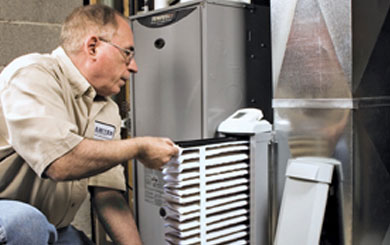 Q: I want the best air for my family. Which type of central air cleaner is best, and will installing one make my heating and cooling more efficient?
Q: I want the best air for my family. Which type of central air cleaner is best, and will installing one make my heating and cooling more efficient?
A: Indoor air quality is becoming a greater issue as homes become more airtight for energy efficiency. And with all the synthetic products used in homes today, indoor air is often more polluted and hazardous to your health than outdoor air.
Installing a high-quality central air cleaner or filter in the furnace/air conditioner duct system does not technically improve the efficiency of your heating and cooling system. What it will do is keep the units running at their highest original efficiency levels. Most air cleaners use little or no electricity to operate.
With a lower-quality air cleaner, such as the standard 1-inch-thick fiberglass filter, dust and dirt can build up on the heat exchanger and cooling coil surfaces. This dust creates a layer of insulation so that heat is not transferred as effectively as it should be, and reduces overall energy efficiency.
If you don’t change the filter often enough, dirt can clog the filter and reduce air flow through it. This further reduces efficiency because the heating and cooling coils and heat exchangers are designed for a specific air-flow rate.
In the past few years, manufacturers have begun producing new, super-efficient central air cleaners. They use a combination of electronic air-charging and filters to trap almost all of the tiniest air particles. They can even catch flu viruses and bacteria as they pass through the duct system.
Standard electronic air cleaners use wires to give air particles a negative charge. A collection cell has plates with a positive charge so the negatively charged particles stick to it. When the collection cell is dirty, you can wash it in the dishwasher or bathtub and slip it back into the unit.
For many, the standard type is adequate, but for people with allergies to smaller indoor air particles, the newer electronic air cleaners with a charged filter may be more effective. The electricity cost to operate either type of air cleaner is not significant.
It’s important to regularly clean the collection cell of the standard electronic air cleaner to keep it operating at maximum performance and reduce the amount of ozone generated. When the cell gets dirty, the charge can arch from the wires to the collection plate and produce excessive concentrations of ozone gas, to which some people are sensitive. You can also set it to a lower charging voltage to reduce ozone.
Another option is a pleated media air cleaner. It’s less expensive and relies on many square feet of folded filter material to catch particles as the air passes through. There are various levels of media quality and price. The cleaning effectiveness of various models can be compared by their MERV (minimum efficiency reporting value) rating.
If you don’t want to have the ducts in your home modified to install a new air cleaner, consider a self-charging electrostatic model. This slips into the existing furnace filter slot and is many times more effective than a fiberglass filter. Just the air flowing over the resin filter material creates a charge that traps more dirt particles.
Another option is a bypass HEPA (high efficiency particle air) cleaner that has its own air circulation motor. It’s a very dense filter, which makes it very effective, but it may create too much resistance for the furnace blower to force adequate air flow through it. The bypass design has its own blower so the air flow through the coils or heat exchanger is not impeded.
With any central air cleaner, it cleans only when a furnace/air conditioner blower is running. To get around this, Aprilaire® offers a new controller which mounts next to the wall thermostat. It allows you to automatically run the blower for any length of time when no heating or cooling is needed.
James Dulley is a nationally recognized mechanical engineer writing about home energy issues for the National Rural Electric Cooperaive Association. Visit dulley.com for more home improvement and do-it-yourself tips.



